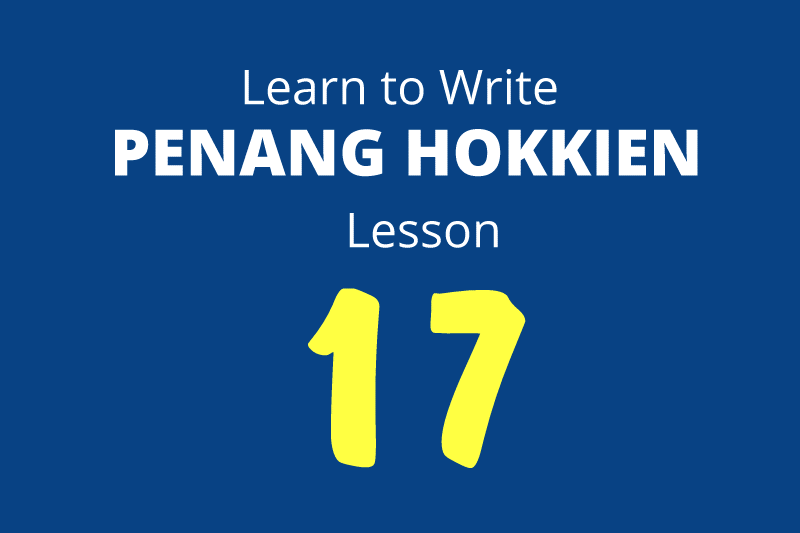
We have gone through many lessons where classifiers (penjodoh bilangan) are used. Finally we now look at classifiers and how we use them.
So far, we have learned the general classifier, leh2
 . That's just one in a plethora of classifiers that you will need to know.
. That's just one in a plethora of classifiers that you will need to know.On top of my head, the only two instances when you do not use a classifier is for time and money. With these two, you can use a number directly with a noun, for example, cit3 tiam1ceng1
 (an hour), cit3 ma3nia4
(an hour), cit3 ma3nia4  (a moment), cit3 khor1
(a moment), cit3 khor1  (a ringgit), etc. For all other instances, you need a classifier, for example, a box (cit3-leh3 ak1
(a ringgit), etc. For all other instances, you need a classifier, for example, a box (cit3-leh3 ak1  ), a duck (cit3-ciak1 ak3
), a duck (cit3-ciak1 ak3  ), a car (cit3-teng1 chia1
), a car (cit3-teng1 chia1  ), a person (cit3-kheok1 lang2
), a person (cit3-kheok1 lang2  ), etc.
), etc.A classifier is also used for a collection of items, or for things within a container, for example, a pair of husband and wife (cit3-tui3-eh3 ang3bor4
 ), a heap of sand (cit3-bu2-eh3 sua1
), a heap of sand (cit3-bu2-eh3 sua1  ), a piece of paper (cit3-tniau1-eh3 cua4
), a piece of paper (cit3-tniau1-eh3 cua4  ), even a car of teachers (cit3-chia1-eh3 sin3snaeh1
), even a car of teachers (cit3-chia1-eh3 sin3snaeh1  ) or a tree of monkeys (cit3-cang2-eh3 kau2
) or a tree of monkeys (cit3-cang2-eh3 kau2  ).
).Notice that we use "-eh3"
 in the same sense as the English "of". In most instances, you have the option whether or not to add "-eh3". Unlike English (where you definitely need "of" in "a piece of"), "-eh3" is often dropped. To say "a heap of sand", you can use both "cit3-bu2-eh3 sua1"
in the same sense as the English "of". In most instances, you have the option whether or not to add "-eh3". Unlike English (where you definitely need "of" in "a piece of"), "-eh3" is often dropped. To say "a heap of sand", you can use both "cit3-bu2-eh3 sua1"  or "cit3-bu3 sua1"
or "cit3-bu3 sua1"  . Which to use? The one with "-eh3" is more emphatic. When you are focused on that matter, you would add "-eh3"; if you're saying something in passing, you might drop "-eh3". In other words, you have to play by the ear and get familiar with the difference.
. Which to use? The one with "-eh3" is more emphatic. When you are focused on that matter, you would add "-eh3"; if you're saying something in passing, you might drop "-eh3". In other words, you have to play by the ear and get familiar with the difference.When you use -eh3, the classifier is in citation tone. Without the -eh3, it is in sandhi tone. Both "cit3-tniau1-eh3 cua4" and "cit3-tniau3 cua4" mean "a piece of paper", but notice the tone on the classifier tniau1
 .
.When a noun that is not usually a classifier is called upon to serve in the classifier role, you cannot drop the "-eh3". To say "cit3-chia1-eh3 sin3sneah1" is fine, but to say "cit3-chia3 sin3sneah1" is wrong, as chia1 is not usually a classifier, but is only used in that phrase in a classifier role.
For a list of classifiers, go to my chapter on the subject:
https://www.penang-traveltips.com/hokkien/classifiers.htm
Don't worry about memorizing each and every one of those classifiers. Let them appear to you naturally as you read Penang Hokkien and make use of the language in writing. It's more important to learn how to use them, and to recognize them when you come across them in reading, and over time, you will become familiar with using the right classifier for the right item.
The usual word order is "number-classifier-eh3 noun", where the "-eh3" is hyphenated to the number, and is often optional if a true classifier is used, but required is a noun acting as classifier is used. Replace the number with kui1 or cor3 ce33/cio4 to form questions. Snar3-boey1 hu2
 Three fish
Three fishCit3-tniau3 cua4
 A piece of paper
A piece of paperCit3-chia1-eh3 lang2
 A car of people
A car of peopleKui1-boey1 hu2?
 Cor3 ce33-boey1 hu2?
Cor3 ce33-boey1 hu2?  How many fish?
How many fish?Place the hyphens when the phrase is followed by the noun; remove the hyphens if the noun is impled. Where the noun is impled, -eh3 is also often dropped.
Snar3 boey4
 Three (fishes)
Three (fishes)Cit3 tniau1
 A piece.
A piece.Cit3 chia1
 A car load.
A car load.Kui1 boey4?
 Cor3 ce33 boey4?
Cor3 ce33 boey4?  How many?
How many?It is common to see the word order inverted, into noun+number+classifier. In such a construction, -eh3 is dropped, the classifier is not hyphenated to the number (it only is when it is followed by the noun), and it is in the citation form.
Hu2 snar3 boey4
 Three fish
Three fishCua4 cit3 tniau1
 A piece of paper
A piece of paperLang2 cit3 chia1
 A car of people
A car of peopleHu2 kui1 boey4?
 Hu2 cor3 ce33 boey4?
Hu2 cor3 ce33 boey4?  How many fish?
How many fish?
Previous Lesson | Main Page | Next Lesson
Language Learning Tools
Use the following language learning tools to learn Penang Hokkien!Learn Penang Hokkien with uTalk
This app opens the door to over 150 languages.Return to Penang Hokkien Resources

Copyright © 2003-2025 Timothy Tye. All Rights Reserved.

 Go Back
Go Back
